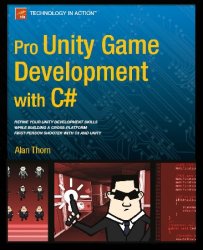
Автор: Alan Thorn
Название: Pro Unity Game Development with C#
Издательство: Apress
Год: 2014
ISBN: 978-1430267461
Язык: English
Формат: pdf
Размер: 11,4 mb
Страниц: 348
C# is the most popular programming language for experienced Unity developers, helping them get the most out of what Unity offers. If you're already using C# with Unity and you want to take the next step in becoming an experienced, professional-level game developer, this is the book you need.
Whether you are a student, an indie developer, or a season game dev professional, you'll find helpful C# examples of how to build intelligent enemies, create event systems and GUIs, develop save-game states, and lots more.
You'll understand and apply powerful programming concepts such as singleton classes, component based design, resolution independence, delegates, and event driven programming.
By the end of the book, you will have a complete first person shooter game up and running with Unity. Plus you'll be equipped with the know-how and techniques needed to deploy your own professional-grade C# games.
If you already know a bit of C# and you want to improve your Unity skills, this is just the right book for you.
About the Author
About the Technical Reviewer
Acknowledgments
Introduction
Chapter 1: Designing and Preparing
Designing
Game Overview
Game in Depth
Developing the Design: Looking Ahead
Game Development Workflows
Tip #1: Interface Layout
Tip #2: Dual-Monitors
Tip #3: Be Organized
Tip #4: Show Project Wizard on Start-up
Tip #5: Use FBX Meshes
Tip #6: Disable Ambient Lighting
Tip #7: Use Root GameObjects
Tip #8: Incremental Backups
Tip #9: Batch Renaming
Tip #10: Showing Empty Objects in the Editor
Tip #11: Use the Stats Panel
Tip #12: Testing Resolution and Aspect Ratio
Conclusion
Chapter 2: Getting Started
Step 1: Create Folders
Step 2: Importing Textures and Meshes
Step 3: FBX Meshes and Scale Factor
Step 4: Configuring Meshes
Step 5: Planning and Configuring Textures
Step 6: Building Sprites
Step 7: Importing Audio
Step 8: Create Prefabs
Step 9: Scene Building
Step 10: Lighting and Lightmapping
Step 11: Building a Navigation Mesh
Conclusion
Chapter 3: Event Handling
Events and Responses
Event Handling
Planning Event Handling
Planning a Dedicated Event-Handling System
Getting Started with NotificationsManager
Keeping Track of Notifications with .NET Dictionaries
Generic Classes and C
Registering As a Listener
Posting Notifications
SendMessage and BroadcastMessage
Removing Listeners
Removing Redundancies
Completing NotificationsManager
Wording with the NotificationsManager
Conclusion
Chapter 4: Power-Ups and Singletons
Creating the Cash Power-Up
Power-Ups and Billboards
Billboards and Cached Transforms
Billboards and Rotation
Billboards and Bobbing
Coroutines
Power-Up Motion with Coroutines and deltaTime
Exploring dettaTime
Completing Power-Up Bobbing
Power-Up Collision
Handling Collision Events: Getting Started
Collisions and Responses
Introducing the GameManager
GameManager and Singletons
GameManager and Event Handling
Completing the Cash Power-Up
Making a Prefab from the Completed Power-Up
Creating Other Prefabs
Conclusion
Chapter 5: Player Controller
Character Controllers and the First Person Controller
Multiplatform Development
Beginning the Universal First Person Controller
Platform Dependent Compilation
Head Bobbing and Sine Waves
First-Person Capsule Mesh
Handling Cash Collection
Life and Death: Getting Started
Making Death: Scripting with Mecanim
Implementing Health
Health and Damage: Procedural Textures
GUIs
Conclusion
Chapter 6: Weapons
Weapons Overview
Object Orientation: Classes and Instances
Object Orientation: Inheritance
Animations, Frames, and Prefabs
Cameras: Layers and Rendering
Cameras: Orthographic Size
Weapon Implementation: Punching
Physics and Damage Dealing
Weapon Changing and Polymorphism
Completing the Punch and Gun Weapons
Conclusion
Chapter 7: Enemies
Meet the Bad Guys
Starting the Enemy Drone Prefab
Coding Enemy Damage
Improving Damage Dealing: Feedback
Enemies, Intelligence, and Philosophical Zombies
Finite State Machines (FSMs)
Changing Between States
Preparing for State Implementation
The Patrol State
Refining the Patrol State
The Chase and Attack States
Adding More Enemy Types
Summary
Chapter 8: Graphical User Interfaces
GUIs in Games
Getting Started with GUIs
Resolution Dependence and Independence
Main Menu and Aspect Ratio
Testing the Main Menu
Adding Buttons to the Main Menu
Handling Button Presses
HUD: Ammo and Health Statuses
Summary
Chapter 9: Handling Persistent Data
Persistent data: PlayerPrefs, Binary Data, and More
Player Preferences Class
File-Based Persistence
Saving with XML
Getting Started with XML: Serialization
Loading from and Saving to an XML File
Completing the GameManager Class
Completing the PlayerController Class
Completing the Enemy Class
Testing Save and Load Functionality
Summary
Chapter 10: Refinements and Improvements
Level Changing
Event Handling
Interfaces
Delegates
Write Shorter Code
Ternary Operator
Null-Coalesce Operator
Automatic Properties
C# Features or Quirlts?
Private Does Not Mean Inaccessible
goto is C# Teleportation
Static is Omnipresent
Braces Define Scope
Summary
Index
|